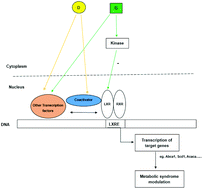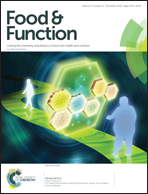Genistein and daidzein decrease food intake and body weight gain in mice, and alter LXR signaling in vivo and in vitro†
Abstract
The study is designed to determine whether consumption of the soy isoflavones, genistein and daidzein, differentially influence metabolic syndrome, and to further investigate the involvement of Liver X Receptor (LXR) regulation. C57BL/6J mice were fed diets as follows: low fat diet (LF), western-style diet (WD), and WD containing 0.16% (w/w) of genistein (WD + G) or daidzein (WD + D) for 10 weeks. Intake of WD + G and WD + D produced a robust decrease in body weight gain by 40% and 19%, respectively (p < 0.05). Genistein reduced energy intake by 26%, and daidzein decreased energy intake by 8% (p < 0.05). A glucose tolerance test indicated that genistein consumption significantly decreased the incremental areas under the curve (AUC) from 60–120 min, compared to WD-fed mice. Gene array profiling of hepatic mRNA, and cell studies utilizing transiently-transfected HepG2 cells and mouse embryonic fibroblast cells devoid of or expressing LXRα, indicate that genistein and daidzein induce LXR-mediated pathways. In summary, addition of genistein, compared to daidzein, to a western-style diet, more profoundly decreased food intake, body weight gain, while both appear to regulate LXR-mediated pathways.



 Please wait while we load your content...
Please wait while we load your content...